“Rural dwellers are not passive respondents to external conservation agents but are active proponents and executers of their own conservation initiatives.”—Noga Shanee, Projects Director for Neotropical Primate Conservation (NPC), in an interview with mongabay.com.
When we think of conservation areas, many of us think of iconic National Parks overseen by uniformed government employees or wilderness areas purchased and run from afar by big-donor organizations like The Nature Conservancy, Wildlife Conservation Society, WWF, or Conservation International. But what happens to ecosystems and wildlife in areas where there’s a total lack of government presence and no money coming in for its protection? This is the story of one rural Peruvian community that took conservation matters into their own hands, with a little help from a dedicated pair of primate researchers, in order to protect a high biodiversity cloud forest.
On the 22nd of November, 2012, the Peruvian Andes village of Líbano celebrated the launch of the Hocicón Reserve, formed under an innovative conservation model in accordance with federal law which allows for local administration of lands by community organizations (in this case the Rondas Campesinas). The new reserve protects an area of tropical Andean cloud forest in one of the most diverse biomes on earth, home to many endangered and unique species including the endemic Andean night monkey (Aotus miconax), the Endangered white-bellied spider monkey (Ateles belzebuth), jaguars, tapirs and many more. Hocicón, a 505.9 hectare protected area, is on the border of the Amazonas and San Martin regions—two of the most densely populated rural regions in Peru with some of the highest deforestation rates in the country. The rural population in these regions—Campesinos or ‘peasant farmers’—are predominantly of mixed indigenous and European origin and, like the native wildlife, are also endangered, by land insecurity and degraded natural resources.
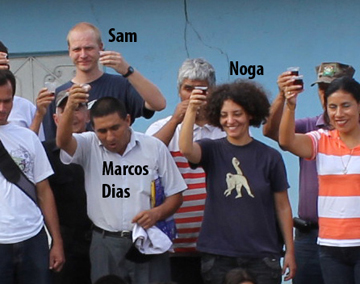 Noga and Sam Shanee have helped provide technical assistance to the creation of the Hocicón reserve. Ronda leader, Marcos Díaz Delgado, was instrumental in the reserve’s creation. Photo courtesy of NPC. |
Noga Shanee and her husband Sam, of the organization Neotropical Primate Conservation (NPC), work primarily in Peru to support the connection between communities and conservation. They live most of each year not far from the Hocicón reserve they helped to create. “We created NPC as a result of our experience as conservation practitioners and the need we felt to finding efficient solutions to the grave situation in which we found the yellow tailed woolly monkey and its habitat,” Noga told mongabay.com.
The Shanees’ work in primate conservation brought them in close contact with local residents, where it became clear that protection of nature might best be achieved by supporting grassroots community efforts. In the last few years, they have administratively assisted in registering seven conservation areas with the local and national governments before helping to establish the Hocicón reserve under the Ronda Campesina group in Libano. Through NPC they offer Libano residents technical support (GPS equipment, GIS mapping, basic biological assessment and the writing of a basic report), advice on quantifying the ecological importance of the area, and help with legal matters.
Such assistance is necessary because according to governmental demands for conservation projects “local initiators have to execute plans of economic activities and reserve maintenance involving factors which many rural campesinos don’t have the capacity and/or resources to undertake,” writes Noga Shanee in a forthcoming article, which details their fieldwork and the many obstacles that prohibit local community groups from establishing official protected areas. “The main restrictions found to Campesino conservation initiatives was a lack of access to support from governmental and non-governmental institutions and a lack of access to economic resources for the extended bureaucratic processes of registering these protected areas.”
![]()
The Andean night monkey (Aotus miconax) is endemic to Peruvian forests which are being protected not by the government or big NGOs, but local communities. Photo by: Andrew Walmsley/NPC.
Noga Shanee says that the bigger problem is disconnect between the state’s expressed desire for conservation and the overly restrictive process of providing for it.
“The Peruvian state presents itself as an enthusiastic promoter of conservation and public participation in environmental issues, taking pride in legislation that allows private and community conservation,” she notes. “However, our experience shows us that the process of legally registering privately run conservation areas is extremely complicated, expensive and slow, requiring teams of specialists and cost on average $20,000 US dollars, just up to the initial registration of the area. After completing this arduous process, the government does not provide any support for the conservation initiators; on the contrary, they require additional reports and economic investments. Therefore, this process is inaccessible to most of the rural population creating inequality and losing opportunities for local participation and conservation efficiency…most local people are unable to create their own reserves and need the help of NGOs. The creation of these reserves including the elaboration of the proposal and waiting for registration takes from 1.5 to 5 years. During this time the land is not legally protected and other land uses are possible which in some cases has led to conflicts.”
One effect of this long, and expensive process is the exclusion of non-experts, small groups, and those lacking connections to government officials or influential NGOs in the process of establishing reserves.
“Although it is perceived locally that broad inter-institutional cooperation would be the best way towards effective regional conservation, cooperation is rare, mainly due to competitiveness related to economic pressures,” Shanee writes.
Launching community reserves from the ground up has proven to be a great way to overcome these bureaucratic obstacles while combating a myriad of threats to both animals and local people.
![]()
Ronderos voting to create Hocicón Reserve. Photo by: Noga Shanee.
“The area suffers from high levels of deforestation fueled by immigration, road construction, extractive industries, hydroelectric dams, cattle ranching and lately a boom of palm oil plantations. The Ronda Campesina [community group, which launched the reserve,] has been protesting for many years against this development model (aggressively promoted by the government) which is so destructive to natural habitats and to rural societies,” Noga Shanee, told mongabay.com.
Such threats are caused by a number of actors, according to Shanee, including the federal government, international corporations, and even the rural campesinos [farmers] themselves.
“Severe economic and social pressures are found to force campesinos into unsustainable practices,” writes Noga Shanee, in a recently submitted paper.
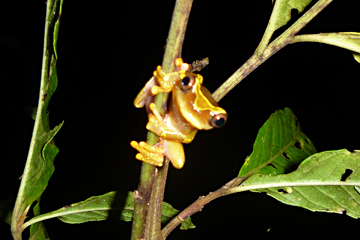 Clown tree frog (Dendropsophus sarayacuensis) in the region. Nestor Allgas Marchena/NPC. |
In her PhD Thesis on the subject written for Kent University in the UK, Noga Shanee summarized that “current conservation efforts are far from sufficient to offset the mounting threats they face,” adding “an amalgam of contradicting agendas, power struggles, superficial-spectacular solutions, and prejudices towards rural populations hinder the efficiency of conservation interventions” as “the immense pressures impacting human populations transforms directly into environmentally degrading processes.”
The Hocicón conservation model is not your typical conservation solution to these problems. In contrast to uniformed park officials greeting visitors or teams of well-paid foreign biologists in the field monitoring wildlife populations, these reserves are organic extensions of the community—policed and patrolled by the local residents themselves; such projects bring, according to Shanee, “a sense of pride and inclusion to the rural people who implement them.”
The Rondas enjoy distinctive legal rights within Peruvian society because of long-standing traditional land claims by indigenous peoples in combination with large areas of territory devoid of governmental or NGO supervision.
“The areas we are working and living in (departments of Amazonas and San Martin in Northern Peru) are almost completely abandoned by the government and would be in complete anarchy if it wasn’t for the Rondas…The Ronda Campesina (Peasant Patrol) is a network of autonomous, civil organizations, aimed at self-protection,” Shanee explains. “They practice vigilance and civil justice in the rural Peruvian countryside where state control is insufficient.”

The royal sunangel (Heliangelus regalis) is listed as Endangered by the IUCN Red List. Photo by: Sachar Alterman/NPC.
Ronda bases can be organized by any population (community, town, or village). Nationally, the Ronda has more than half a million active members, in more than 5,000 bases, mainly, but not only, in Northern Peru and solves about 180,000 civil justice cases per year. Rondas also protest against external environmental hazards, such as polluting mining operations. According to Noga Shanee’s thesis, “by criticism and setting examples, the Rondas pressure both the government and NGOs to act more efficiently and morally towards conservation.”
Sam Shanee, also of NPC, says Ronda self-government is purely for protective purposes. “The ronda is basically a neighborhood watch group in most villages (I myself am a ‘rondero’ in the village where we live). All that this new approach entails in its most basic form is a group of villagers (or the entire village) getting together a deciding to protect an area of forest or other natural habitat near where they live… there has been no use of force for the creation of this first ARCA and the Ronda is not really a militia organization except when necessary, for example in the face of terrorism, drug cartels, illegal mining/logging etc.”
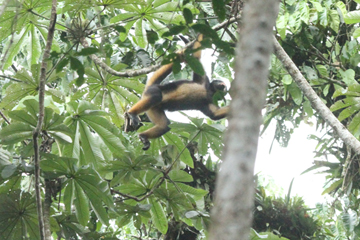 White-bellied spider monkey (Ateles belzebuth). Photo by: Shachar Alterman. |
In the absence of top-down support or supervision, the Rondas offer their own path to conservation. The Ronda-run Conservation Areas, known as ARCAs, are quick, extremely low-cost, and are uniquely tailored to the Ronda social structure, allowing for participation of local people in conservation efforts, according to the Shanees.
Marcos Díaz Delgado, a national Ronda leader, told mongabay.com that “The [Ronda-run Conservation Areas (ARCAs)] are an alternative to the state’s legal conservation system which is extremely slow, expensive and fails to reach many remote, rural parts of our country. As a special jurisdiction we don’t only defend our safety and our human rights, but we also defend the natural world inside our territories. We invite the state authorities and all social organizations to join us for the collective defense of our natural resources.”
The ARCAs were designed to streamline the process of establishing protected areas: because of the Rondas special legal status, they only necessitate the minimal process (mapping and basic biological info), and cost almost nothing. Therefore “the Ronda Campesina’s conservation initiatives are an honest and efficient answer to habitat and species loss in Peru as well as to the deficiencies of mainstream, non participative conservation,” Noga Shanee says, adding that while this project is a collaboration between NPC and the Ronda, “we are hoping that they will become more and more self sufficient with time…our help is trying to organize, augment and formalize this initiative”.
Orin Starn, Chair and Professor of Cultural Anthropology at Duke University, and author of the book Night Watch, the Politics of Protest in the Andes, told mongabay.com that, “the Rondas are the largest, most influential grassroots movement in Peru’s northern mountains. Environmentalism is a relatively new development to this area, and it’ll be very interesting to see the directions that this new collaboration between an old peasant movement and the new NGO-driven green activism may take.”
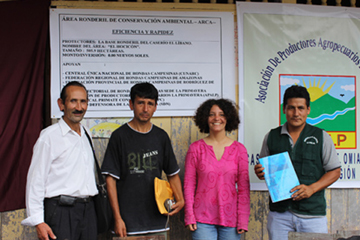 Noga Shanee (in pink) with community members. Photo courtesy of NPC. |
The Shanees’ work in the Amazon continues to illustrate the close biocultural connection between nature and community. Noga sees this connection as a positive force for change when strengthened. In her thesis she writes that destructive pressures on local communities and forests “also create positive consequences by creating new conservation opportunities.” By turning local environmental and social crisis into opportunity, new collaborations and conservation without supervision, born of necessity, can emerge, offering real hope for biocultural diversity.
“All over the world there are small groups of local farmers and indigenous people that organize themselves in order to protect their neighboring forests,” Noga Shanee says. “These initiatives are rarely heard about as these people often lack resources and expertise to promote their successes through academic or popular publications.” But she adds that she hopes the Hocicón model will become increasingly common in Peru and even spread abroad.
“This initiative can inspire other grassroots organizations to organize themselves to administer conservation, which could benefit many different species and habitats around the world. ”
She believes that community-run conservation will prosper, saying, “we might be naïve and of course this project can fail, but our work in Peru has shown us that local communities put huge efforts in conserving their forests, usually with no help from mainstream conservationists and sometimes even despite them. We believe that they deserve the chance.”

Cloud forest in Northeastern Peru. Photo by: Andrew Walmsley/NPC.
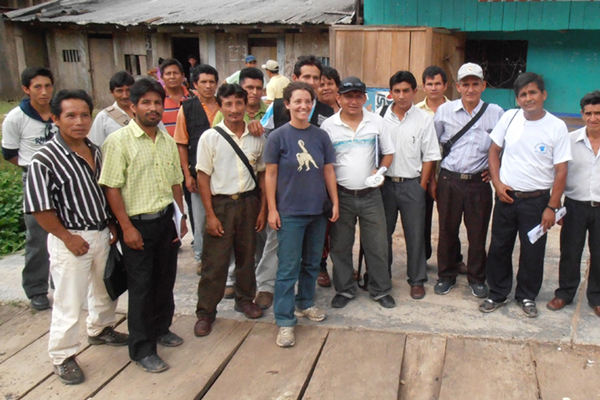
Noga in front in purple with community leaders. Photo courtesy of NPC.
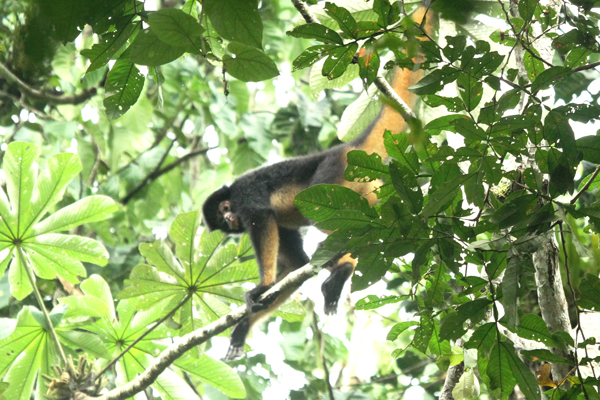
White-fronted spider monkey (Ateles belzebuth). Photo by: Shachar Alterman.
CITATIONS:
Shanee N (2012) The Dynamics of Threats and Conservation Efforts for the Tropical Andes Hotspot in Amazonas and San Martin, Peru. PhD Thesis (Kent University, Canterbury). Supervised by Prof. Stuart R. Harrop.
Shanee, Noga, Sam Shanee, and Robert H. Horwich (2012 in revision). “Locally run conservation initiatives in northeastern Peru and their effectiveness as conservation methods,” shared by permission of the authors
Starn O (1999) Nightwatch: the politics of protest in the Andes (Duke Univ Pr, Los Angeles) p 329.
Chapin, M. (2004) A Challenge to Conservationists. World Watch, 17, 17-31
Sobrevila, Claudia. (2008) “The Role of Indigenous Peoples in Biodiversity Conservation; The Natural but Often Forgotten Partners” World Bank Report.
Related articles
Innovative idea: wildlife income may help people withstand drought in Africa
(03/18/2013) Getting local people to become invested in wildlife conservation is not always easy, especially in parts of the world where protected areas are seen as taking away natural resources from local communities. This tension lies around Gonarezhou National Park in Zimbabwe, where a growing population of livestock herders competes with wildlife.
Warlords, sorcery, and wildlife: an environmental artist ventures into the Congo
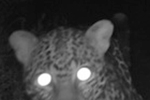
(02/25/2013) Last year, Roger Peet, an American artist, traveled to the Democratic Republic of Congo (DRC) to visit one of the world’s most remote and wild forests. Peet spent three months in a region that is largely unknown to the outside world, but where a group of conservationists, headed by Terese and John Hart, are working diligently to create a new national park, known as Lomami. Here, the printmaker met a local warlord, discovered a downed plane, and designed a tomb for a wildlife ranger killed by disease, in addition to seeing some of the region’s astounding wildlife. Notably, the burgeoning Lomami National Park is home to the world’s newest monkey species, only announced by scientists last September.
Livelihoods depend on the environment in the Western Ghats
(09/27/2012) In the Uttar Kannada district of the Western Ghats, the livelihood of the average individual depends largely on the well being of the environment. Six months ago, before large-scale mangrove planting of the area, if someone were to walk through the banks of the mangroves in the Western Ghats he would see many fishermen casting their long nets and wires, time and time again noticing pieces of trash such as plastic grocery bags tangled in the nets.
Local knowledge matches scientific data on wildlife abundances
(09/17/2012) How far can scientists trust local knowledge when it comes to ecosystems? This is a question that is undergoing heavy debate in scientific circles. A new study in mongabay.com’s open access journal Tropical Conservation Science contributes to the debate by finding that basic local knowledge of animal abundance in Gonarezhou National Park, Zimbabwe aligned closely with scientific surveys.
Human rights key to rainforest conservation, argues report
(09/06/2012) Recognizing the rights of forest people to manage their land is critical to reducing deforestation rates and safeguarding global forests, argues a new report published by Rainforest Foundation Norway.
Turning gorilla poachers into conservationists in the Congo [warning: graphic photos]
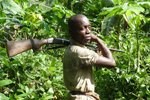
(08/13/2012) Although founded only four years ago, Endangered Species International-Congo, has ambitious plans to protect dwindling Western gorilla populations and aid local people in the Republic of the Congo. The organization, an offshoot of Endangered Species International (ESI), has been spending the last few years studying the bushmeat trade in Pointe-Noire, the country’s second largest city, and developing plans for turning hunters into conservationists.